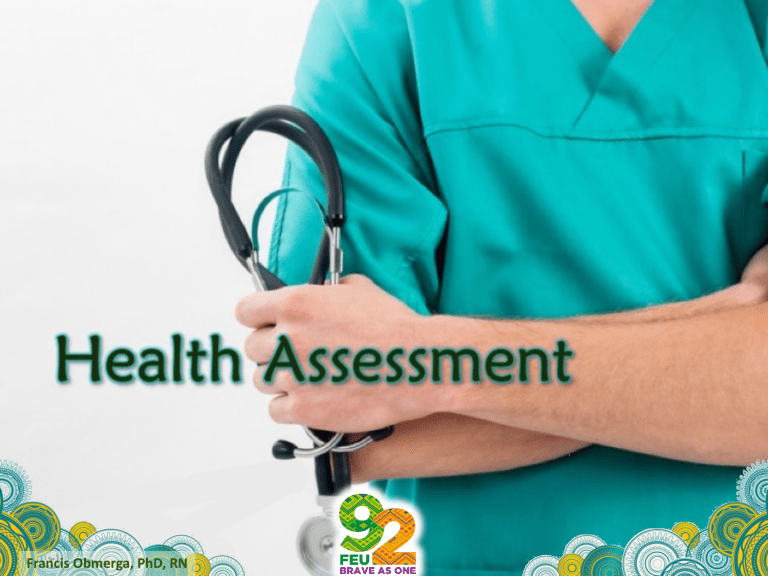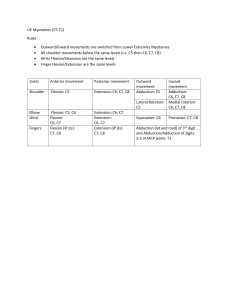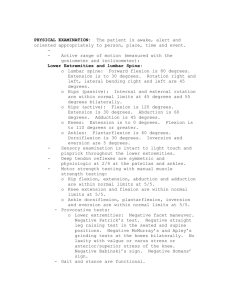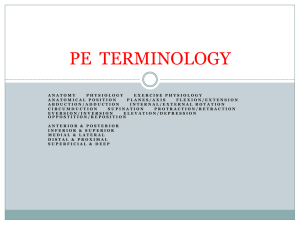
Francis Obmerga, PhD, RN Muscles NORMAL FINDINGS Inspect the muscles for size. Compare each muscle on one side of the body to the same muscle on the other side. For any apparent discrepancies, measure the muscles with a tape. Equal size on both sides of body DEVIATION FROM NORMAL Atrophy (a decrease in size) or hypertrophy (an increased in size) Muscles of the body Muscles NORMAL FINDINGS Inspect the muscles and tendons for contractures. No contractures DEVIATION FROM NORMAL Malposition of body part (foot drop or foot flexed forward) Muscles NORMAL FINDINGS Inspect the muscles for tremors. Inspect any tremors of the hands and arms by having the client hold arms out in front of body. No fasciculation or tremors DEVIATION FROM NORMAL Presence of fasciculation or tremors Muscles NORMAL FINDINGS Palpate muscles at rest Normally firm to determine muscle tonicity. Palpate muscles while Smooth coordinated the client is active and movements passive for flaccidity, spasticity, and smoothness of movement. Test muscle strength. Equal strength on each Compare the right side body side with left side. DEVIATION FROM NORMAL Atonic (lacking tone) Flaccidity (weakness or laxness) or spasticity (sudden involuntary muscle contraction) 25% or less muscle strength Grading Muscle Strength GRADE 5 4 3 2 1 0 DESCRIPTION 100% of normal muscle strength; normal full movement against gravity and against full resistance. 75% of normal strength; normal full movement against gravity and against minimal resistance. 50% of normal strength; normal movement against gravity. 25% of normal strength; full muscle movement against gravity, with support. 10% of normal strength; no movement, contraction of muscle is palpable or visible. 0% of normal strength; complete paralysis 5/9/23 7:09 AM Lecturer: FRANCIS OBMERGA, 7 Sternocleidomastoid Client turns the head to one side against the resistance of your hand. Repeat with the other side. Trapezius Client shrugs the shoulders against the resistance of your hands. Deltoid Client holds arm up and resists while you try to push it down. Biceps Client fully extends each arm and tries to flex it while you attempt to hold arm in extension. Triceps Client flexes each arm and then tries to extends it against your attempt to keep in flexion Wrist and Finger Muscles Client spreads the fingers and resists as you attempt to push the fingers together. Grip strength Client grasps your index finger and middle fingers while you try to pull the fingers out. Hip Muscles Client is supine, both legs extended; client raises one leg at a time while you attempt to hold it down. Hip abduction Client is supine, both legs extended. Place your hands on the lateral surface of each knee; client spreads the legs apart against your resistance. Hip adduction Client is in same position as in hip abduction. Place your hands between the knees; client brings the legs together against your resistance. Hamstrings Client is supine, both knees bent. Client resists while you attempt to straighten the legs. Quadriceps Client is supine, knee partially extended; client resists while you attempt to flex the knee. Muscles of the ankle and feet Client resists while you attempt to dorsiflex the foot and and again resists while you attempt to flex the foot. Bones NORMAL FINDINGS Inspect the skeleton for normal structure and deformities. Palpate the bones to locate any areas of edema or tenderness. DEVIATION FROM NORMAL No deformities Bones misaligned No tenderness of swelling Presence tenderness of swelling Joints NORMAL FINDINGS Inspect the joint for swelling. Palpate each joint for tenderness, smoothness of movement, swelling, crepitation, and presence of nodules. DEVIATION FROM NORMAL No swelling One or more swollen No tenderness, joints. crepitation, or nodules Presence of tenderness, swelling, crepitation, or nodules Understanding Major Joints Understanding Major Joints Understanding Major Joints Understanding Major Joints Joints NORMAL FINDINGS Assess joint range of Varies to some degree in accordance with motion. Ask the client to move selected body parts. If available, use a goniometer to measure the angle of the joint in degrees. Palpate each joint for tenderness, smoothness of movement, swelling, crepitation, and presence of nodules. person’s genetic makeup and degree of physical activity. Full range of motion. DEVIATION FROM NORMAL Limited range of motion in one or more joints Skeletal muscle movements: • Abduction: Moving away from midline of the body • Adduction: Moving toward midline of the body • Circumduction: Circular motion • Inversion: Moving inward • Eversion: Moving outward • Extension: Straightening the extremity at the joint and increasing the angle of the joint • Hyperextension: Joint bends greater than 180 degrees • Flexion: Bending the extremity at the joint and decreasing the angle of the joint Dorsiflexion: Toes draw upward to ankle Plantar flexion: Toes point away from ankle Pronation: Turning or facing downward Supination: Turning or facing upward Protraction: Moving forward Retraction: Moving backward Rotation: Turning of a bone on its own long axis Internal rotation: Turning of a bone toward the center of the body • External rotation: Turning of a bone away from the center of the body • • • • • • • • Flexion. Move the head from the upright midline position forward, so that the chin rests on the chest; Extension. Move the head from the flexed position to the upright position; Hyperextension. Move the head from the upright position back as far as possible. Neck-Pivot Joint 5/9/23 7:10 AM 23 Lateral flexion. Move the head laterally to the right and left shoulders Neck-Pivot Joint 5/9/23 7:10 AM 25 Rotation. Turn the face as far as possible to the right and left Neck-Pivot Joint 5/9/23 7:10 AM 27 Flexion. Raise each arm from a position by the side forward and upward to a position beside the head; Extension. Move each arm from a vertical position beside the head forward and down to a resting position at the side of the body; Hyperextension. Move each arm from a resting side position to behind the body. Shoulder-Ball-and-Socket Joint 5/9/23 7:10 AM 29 Abduction. Move each arm laterally from a resting position at the sides to a side position above the head, palm of the hand away from the head; Adduction (anterior). Move each arm from a position at the sides across the front of the body as far as possible. The elbow may be straight or bent. Shoulder-Ball-and-Socket Joint 5/9/23 7:10 AM 31 Circumduction. Move each arm forward, up, back, and down in a full circle Shoulder-Ball-and-Socket Joint 5/9/23 7:10 AM 33 External rotation. With each arm held out to the side at shoulder level and the elbow bent to a right angle, fingers pointing down, move the arm upward so that the fingers point up; Internal rotation. With each arm held out to the side at shoulder level and the elbow bent to a right angle, fingers pointing up, move the arm forward and down so that the fingers point down Shoulder-Ball-and-Socket Joint 5/9/23 7:10 AM 34 Flexion. Bring each lower arm forward and upward so that the hand is at the shoulder; Extension. Bring each lower arm forward and downward, straightening Elbow-Hinge Joint 5/9/23 7:10 AM 36 Rotation for supination. Turn each hand and forearm so that the palm is facing upward; Rotation for pronation. Turn each hand and forearm so that the palm is facing downward. Elbow-Hinge Joint 5/9/23 7:10 AM 38 Flexion. Bring the fingers of each hand toward the inner aspect of the forearm; Extension. Straighten each hand to the same plane as the arm. Wrist-Condyloid Joint 5/9/23 7:10 AM 40 Hyperextension. Bend the fingers of each hand back as far as possible. Wrist-Condyloid Joint 5/9/23 7:10 AM 42 Radial flexion (abduction). Bend each wrist laterally toward the thumb side with hand supinated; Ulnar flexion (adduction). Bend each wrist laterally toward the fifth finger with the hand supinated. Wrist-Condyloid Joint 5/9/23 7:10 AM 43 Flexion. Make a fist with each hand; Extension. Straighten the fingers of each hand; Hyperextension. Bend the fingers of each hand back as far as possible. Wrist-Condyloid Joint 5/9/23 7:10 AM 45 Abduction. Spread the fingers of each hand apart; Adduction. Bring the fingers of each hand together. Wrist-Condyloid Joint 5/9/23 7:10 AM 47 Flexion. Move each thumb across the palmar surface of the hand toward the fifth finger; Extension. Move each thumb away from the hand. Thumb-Saddle Joint 5/9/23 7:10 AM 48 Abduction. Extend each thumb laterally; Adduction. Move each thumb back to the hand. Thumb-Saddle Joint 5/9/23 7:10 AM 49 Opposition. Touch each thumb to the top of each finger of the same hand. The thumb joint movements involved are abduction, rotation, and flexion. Thumb-Saddle Joint 5/9/23 7:10 AM 50 Flexion. Move each leg forward and upward. The knee may be extended or flexed. Hip-Ball-and-Socket Joint 5/9/23 7:10 AM 51 Extension. Move each leg back inside the other. Hyperextension. Move each leg back behind the body. Hip-Ball-and-Socket Joint 5/9/23 7:10 AM 52 Abduction. Move each leg out to the side; Adduction. Move each leg back to the other leg and beyond in front of it. Hip-Ball-and-Socket Joint 5/9/23 7:10 AM 55 Circumduction. Move each leg backward, up, to the side, and down in a circle Hip-Ball-and-Socket Joint 5/9/23 7:10 AM 57 Internal rotation. Turn each foot and leg inward so that the toes point as far as possible toward the other leg; External rotation. Turn each foot and leg outward so that the toes point as far as possible away from the other leg. Hip-Ball-and-Socket Joint 5/9/23 7:10 AM 58 Flexion. Bend each leg, bringing the heel toward the back of the thigh. Extension. Straighten each leg, returning the foot to its position beside the other foot. Knee-Hinge Joint 5/9/23 7:10 AM 59 Extension (plantar flexion). Point the toes of each foot downward; Flexion (dorsiflexion). Point the toes of each foot upward. Ankle-Hinge Joint 5/9/23 7:10 AM 60 Eversion. Turn the sole of each laterally; Inversion. Turn the sole of each foot medially. Foot-Gliding 5/9/23 7:10 AM 61 Flexion. Curl the toe joints of each foot downward; Extension. Straighten the toes of each foot. Toes 5/9/23 7:10 AM 62 Flexion. Bend the trunk toward the toes; Extension. Straighten the trunk from a flexed position; Hyperextension. Bend the trunk backward. Trunk-Gliding Joint 5/9/23 7:10 AM 63 Lateral flexion. Bend the trunk to the right and to the left. Trunk-Gliding Joint 5/9/23 7:10 AM 65 Rotation. Turn the upper part of the body from side to side. Trunk-Gliding Joint 5/9/23 7:10 AM 66


